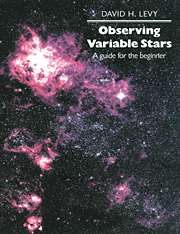Book contents
- Front Matter
- Contents
- Foreword
- Opening thoughts
- Acknowledgments
- Part 1 Getting to know the sky
- Part 2 Getting to know the variables
- 5 Meeting the family
- 6 Getting started with Cepheids
- 7 Algol, the demon of autumn
- 8 How to estimate a variable
- 9 Names and records
- 10 Observing hints
- 11 Stately and wonderful
- 12 Stars of challenge
- 13 Bright, easy, and interesting
- 14 Betelgeuse: easy and hard
- 15 Not too regular
- 16 Nova? What Nova?
- 17 Supernovae
- 18 Three stars for all seasons
- 19 A nova in reverse?
- 20 RU Lupi?
- 21 Orion, the star factory
- 22 Other variable things
- 23 The Sun
- Part 3 Suggested variables for observation throughout the year
- Part 4 A miscellany
- Index
18 - Three stars for all seasons
Published online by Cambridge University Press: 22 September 2009
- Front Matter
- Contents
- Foreword
- Opening thoughts
- Acknowledgments
- Part 1 Getting to know the sky
- Part 2 Getting to know the variables
- 5 Meeting the family
- 6 Getting started with Cepheids
- 7 Algol, the demon of autumn
- 8 How to estimate a variable
- 9 Names and records
- 10 Observing hints
- 11 Stately and wonderful
- 12 Stars of challenge
- 13 Bright, easy, and interesting
- 14 Betelgeuse: easy and hard
- 15 Not too regular
- 16 Nova? What Nova?
- 17 Supernovae
- 18 Three stars for all seasons
- 19 A nova in reverse?
- 20 RU Lupi?
- 21 Orion, the star factory
- 22 Other variable things
- 23 The Sun
- Part 3 Suggested variables for observation throughout the year
- Part 4 A miscellany
- Index
Summary
I owe Rick Hill ten dollars.
It all started one evening when we were discussing the unpredictability of these strange stars we call recurrent novae. Suddenly Rik proposed a wager. Suppose, for example, T Corona Borealis erupts every 80 years. With its last outburst in, say, 1946, I could bet ten dollars that it would next erupt around 2026.
This would be quite a wager, with uncertainty so great that were Rik to bet on 2000 and me to say 2050, we would stand an equal chance of winning.
Since I didn't want to keep ten dollars in some distant bank that long, I suggested we try a dwarf nova, a star that erupts about every 50 days, not years. “No, SS Cyg is too regular,” Rik countered. “There are variable stars that make much better bets.”
Anyway, I talked him into a $10 wager on SS Cygni. A week later, at 11:30 p.m., in the midst of a dark southern Arizona night, the telephone rang ominously.
It was Rik. “Have you seen SS Cyg tonight?” SS Cygni is regular? Who says? It went into outburst seven days early! And I lost my bet!
Even at minimum this star shines at a not-too-faint twelfth magnitude, visible with a city-bound 20 cm (8 inch) telescope. The field is not easy to find, but once you succeed, it is easy to remember (Fig. 18.1).
- Type
- Chapter
- Information
- Observing Variable StarsA Guide for the Beginner, pp. 79 - 88Publisher: Cambridge University PressPrint publication year: 1989

